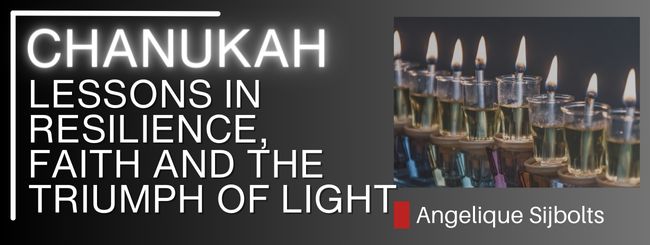בס”ד
Introduction
Chanukah, also known as the Festival of Lights, commemorates the historical triumph of the Maccabees over religious oppression and the miraculous eight-day burning of the menorah. This celebration symbolizes resilience, faith, and the enduring spirit of the Jewish people against adversity.
Chanukah, the story
The story of Chanukah unfolds around the Jewish year 3597 (165 BCE) when the Jewish people were under the rule of the Seleucid king Antiochus IV. Antiochus sought to assimilate the Jews and detach them from the Torah, urging them to deny their belief in Hashem and the Messiah. He enforced his heathen Greek practices upon them, practices that contradicted Jewish traditions, including:
1. **Hellenization:** Antiochus IV attempted to assimilate the Jewish people into Greek culture. This included adopting the Greek language, clothing, and customs, contradicting Jewish traditions and lifestyle.
2. **Prohibition of Jewish rituals:** Antiochus prohibited certain Jewish rites and practices, including observing the Sabbath, circumcision, and the study of the Torah. This was intended to undermine the religious identity of the Jewish people.
3. **Idolatry:** In the Temple of Jerusalem, idolatrous practices were introduced, including the sacrifice of pigs, an animal considered unclean according to Jewish law.
A group of Jewish rebels, known as the Maccabees, revolted against the Seleucid empire. After years of struggle, they succeeded in reclaiming the Temple in Jerusalem. However, when they wanted to rededicate the Temple and light the menorah, they discovered that all the oil jars had been ritually defiled by the Greeks. Nevertheless, one small jar of oil, enough for only one day, was found with an unbroken seal of the Kohen Gadol (High Priest), indicating that the Syrian-Greeks had not tampered with it or even seen it. This oil was suitable for use in the menorah.
Chanukah, the miracle
The question arises: Couldn’t they have waited until they had enough oil to keep it burning continuously? Pure oil of the highest quality, required for the menorah, could only be obtained from Tekoa, located in the tribal portion of Asher. Tekoa was a four-day journey from Jerusalem. Thus, it required four days to reach Tekoa and another four to return. Despite this, they decided to light the menorah, demonstrating an intense desire to rededicate the Temple. It also displayed incredible faith and trust in G-d that He would ensure the menorah continued to burn.
The first day, the first candle of Chanukah, perhaps represents the greatest miracle, signifying that despite oppression, prohibitions, war, the Jewish people will always prevail and continue to serve G-d in the manner He desires. The first candle on the 25th of Kislev is thus a sign of the miraculous victory the Hasmoneans experienced in the war, casting off Greek practices and once again freely practicing Jewish traditions.
The remaining seven candles symbolize the other seven days marking the miraculous burning of the menorah. The light from the menorah resembled the great hidden light that will radiate in full glory in the Messianic Era. This light was the original light created by G-d on the first day of creation, extremely powerful and visible from one end of the world to the other. Reflecting upon the wickedness of man, G-d hid it for the future, when Mashiach (the Messiah) will reveal himself (Chagigah 12a).[1] It demonstrates that when people place their trust in G-d, He can save, help, and redeem them supernaturally. Chanukah is the festival celebrating the triumph of the Jewish people over their enemies, oppression, and the preservation of their religious identity.
Summery
Chanukah signifies the Maccabean victory and the miraculous eight-day menorah flame, embodying the enduring spirit of the Jewish people in the face of adversity.
From this story, we can glean several valuable lessons
1. **Resilience Amidst Oppression:** Chanukah teaches the enduring strength and resilience of the Jewish people in the face of religious oppression, symbolized by the Maccabees’ triumph over the Seleucid rule.
2. **Faith and Miracles:** The holyday underscores the power of faith as seen in the miracle of the menorah’s oil lasting eight days, a testament to divine intervention and the significance of unwavering belief.
3. **Preservation of Identity:** Chanukah emphasizes the importance of preserving one’s cultural and religious identity despite external pressures, as the Maccabees fought to maintain Jewish traditions against Hellenistic influences.
4. **Triumph of Light Over Darkness:** The lighting of the menorah represents the triumph of light over darkness, symbolizing hope, enlightenment, and the ability to dispel adversity with the illumination of faith.
5. **Celebration of Freedom:** Chanukah serves as a celebration of freedom, commemorating not only the rededication of the Temple but also the broader concept of religious and cultural freedom for the Jewish people.
By Angelique Sijbolts
Sources:
[1] According to the Midrash (Tanchuma, Parshat Noah 3) it was hidden in the Torah to benefit those who toil in the Oral Torah day and night.
Check out our other blogs on Chanukah.
© Copyright, all rights reserved. If you enjoyed this article, we encourage you to distribute it further.
Our blogs may contain texts/ quotes or references of
Mechon-Mamre.org, Aish.com, Sefaria.org or AskNoah.org
that contain copyrights and which we may use with there permission.
